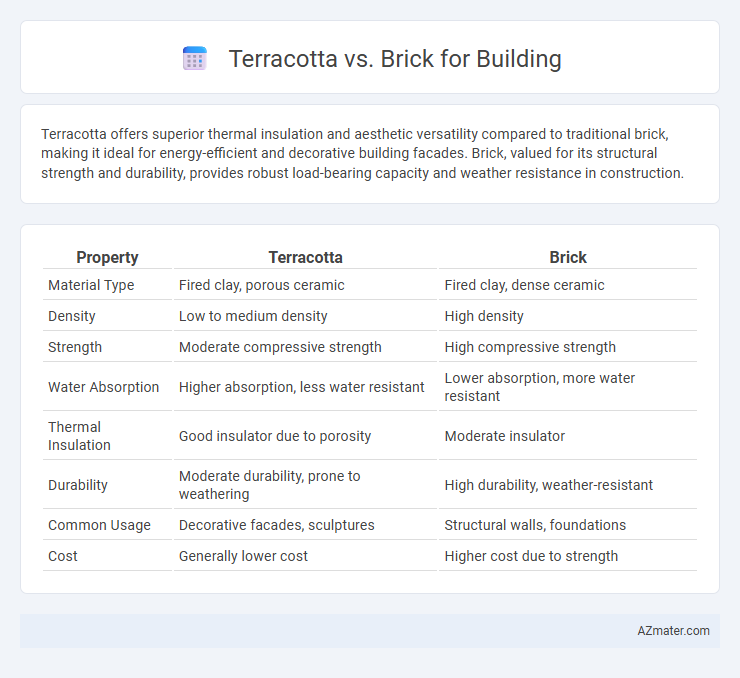Terracotta offers superior thermal insulation and aesthetic versatility compared to traditional brick, making it ideal for energy-efficient and decorative building facades. Brick, valued for its structural strength and durability, provides robust load-bearing capacity and weather resistance in construction.
Table of Comparison
| Property | Terracotta | Brick |
|---|---|---|
| Material Type | Fired clay, porous ceramic | Fired clay, dense ceramic |
| Density | Low to medium density | High density |
| Strength | Moderate compressive strength | High compressive strength |
| Water Absorption | Higher absorption, less water resistant | Lower absorption, more water resistant |
| Thermal Insulation | Good insulator due to porosity | Moderate insulator |
| Durability | Moderate durability, prone to weathering | High durability, weather-resistant |
| Common Usage | Decorative facades, sculptures | Structural walls, foundations |
| Cost | Generally lower cost | Higher cost due to strength |
Introduction to Terracotta and Brick
Terracotta is a clay-based ceramic material known for its porous nature and distinctive reddish-brown color, commonly used in architectural elements and decorative facades. Bricks are traditionally formed from fired clay or shale, offering high strength and durability for structural building purposes. Both materials provide thermal insulation and weather resistance, but their composition and aesthetic properties influence their specific application in construction.
Composition and Manufacturing Processes
Terracotta is a ceramic material composed primarily of refined clay fired at lower temperatures between 1,000degC and 1,150degC, which allows for a porous, lightweight structure with distinct reddish-brown hues. Bricks are typically made from natural clay or shale, molded and fired at higher temperatures around 1,200degC to 1,300degC, resulting in denser, more durable construction units with fewer pores. The manufacturing process of terracotta involves shaping and drying before kiln-firing to achieve intricate shapes and finishes, whereas brick production emphasizes uniformity and strength through automated extrusion or molding followed by high-temperature firing.
Historical Uses in Architecture
Terracotta has been widely used in historical architecture, particularly in ancient civilizations such as Mesopotamia and the Roman Empire, for decorative elements, facades, and roofing due to its malleability and fire-resistant properties. In contrast, bricks, dating back over 7,000 years, served as fundamental building units in structures like the Great Wall of China and the Indus Valley Civilization, valued for their durability, thermal insulation, and structural strength. The use of terracotta and brick reflects significant advancements in material technology, shaping architectural styles and construction techniques from early settlements to classical and Gothic periods.
Aesthetic Differences and Design Appeal
Terracotta offers rich, earthy tones with a handcrafted texture that enhances rustic and traditional architecture, creating warm, inviting facades. Bricks provide a more uniform appearance with diverse color options from red to buff, supporting modern, sleek designs and precise patterns. The choice between terracotta and brick significantly influences a building's visual identity, balancing natural charm against structural regularity for desired aesthetic outcomes.
Structural Strength and Durability
Terracotta offers high compressive strength and excellent resistance to weathering, making it a durable choice for building facades and decorative elements. Bricks, especially fired clay bricks, provide robust structural strength ideal for load-bearing walls and long-lasting construction. Both materials exhibit strong durability, but bricks often outperform terracotta in impact resistance and overall longevity in heavy structural applications.
Thermal Insulation and Energy Efficiency
Terracotta offers superior thermal insulation compared to traditional brick due to its porous structure, which helps regulate indoor temperatures and reduce energy consumption for heating and cooling. Bricks, while durable and effective, typically have higher thermal conductivity, leading to greater heat transfer and less energy efficiency in buildings. Choosing terracotta can significantly enhance energy efficiency in construction by minimizing heat loss and maintaining stable indoor climates.
Environmental Impact and Sustainability
Terracotta exhibits lower environmental impact due to its natural composition and less energy-intensive manufacturing process compared to traditional fired bricks, which require higher kiln temperatures and emit more greenhouse gases. Terracotta's durability and recyclability enhance its sustainability by reducing material waste and the need for frequent replacements. Bricks, while durable, often involve greater extraction of clay resources, contributing to soil degradation and increased carbon footprints.
Cost Comparison and Budget Considerations
Terracotta panels generally come with a higher initial cost compared to traditional bricks, driven by manufacturing complexity and material quality. Brick offers a more budget-friendly option due to its widespread availability and lower production expenses, making it suitable for cost-sensitive projects. Long-term maintenance and durability factors also influence overall budget allocation, with terracotta often requiring less upkeep, potentially offsetting its upfront cost.
Maintenance and Longevity
Terracotta offers superior resistance to weathering and requires less frequent maintenance compared to traditional brick due to its glazed surface that prevents moisture absorption. Brick is durable and has a proven lifespan exceeding 100 years, but it may demand regular repointing and sealing to prevent water damage and mortar deterioration. Choosing terracotta can reduce long-term upkeep costs, while brick provides a robust option with well-established repair techniques for sustained structural integrity.
Choosing the Right Material for Your Building Project
Terracotta offers excellent thermal insulation and aesthetic appeal with its natural earthy tones, making it ideal for sustainable and decorative building projects. Brick provides superior structural strength and durability, suitable for load-bearing walls and long-lasting construction. Selecting the right material depends on project requirements such as insulation efficiency, structural demands, budget constraints, and desired architectural appearance.

Infographic: Terracotta vs Brick for Building
 azmater.com
azmater.com